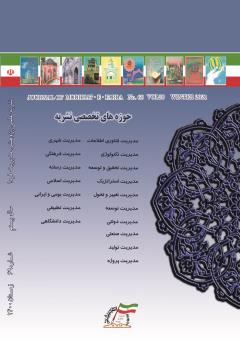Compilation of structural model, dimensions of organizational performance, opportunities, threats, weakness and strength, social security organization
Subject Areas :ommolbanin gilan 1 , bagher sarokhani 2 , seyedmohamad seyedmirzaei 3
1 - PhD student in Sociology, Science and Research Department, Islamic Azad University, Tehran, Iran
2 - Professor, Department of Sociology, Islamic Azad University, Science and Research Branch, Tehran, Iran
3 - Professor, Department of Demography, Islamic Azad University, Faculty of Science and Research, Tehran, Iran
Keywords: Organizational Performance, Opportunities, Threats, Weaknesses, Strengths, Social Security,
Abstract :
The Social Security Administration, as the largest provider of social security in the country, is constantly interacting with the internal and external environment. Therefore, understanding this process leads to a kind of programming based on a realistic view of the dimensions of organizational performance. The purpose of the present study is to provide a structural model of organizational performance dimensions based on environmental changes and opportunities, threats and weaknesses in the organization. This research is based on data type, quantitative and purpose, applied research and method, descriptive correlation and specifically structural equation model. The statistical population of the present study are experts of the Social Security Organization with 13 people and the employees were selected according to the 9 variables observed in the model. Allocation of coefficient 30 with more than 300 estimates in a simple random method was done with equal chance. SPSS software analysis methods and statistical tools have been used to analyze the research data. The results show that the paths of opportunities, strengths, weaknesses and threats have a significant and direct effect on organizational performance and also the values obtained from the coefficient of determination indicate a significant level of effect, which has the greatest effect on strengths and the least effect.
پیوس- اباذریان طهران، محمد؛ حبیبی، علیرضا؛ حبیبی، مرتضی. (1399). بررسی تأثیر هویتسازمانی بر عملکرد سازمانی و مشتری مداری در صنعت بیمه (نمونه موردی: شرکت بیمه سامان)، رویکردهای پژوهشی نوین در مدیریت و حسابداری، بهار 1399، شماره 28 (جلد دوم).
استونر، جيمز اي. اف، فري من، آر. ادوارد، گيلبرت، دانيل آر. (1379). مديريت، ترجمه دكتر علي پارسائيان و دكتر سيد محمد اعرابي، تهران: انتشارات دفتر پژوهشهاي فرهنگي.
بیلو، پاتریک جان؛ شریفی کلوبی، منصور. (1376). راهنمای اجرایی برنامهریزی استراتژیک، تهران، نشر آردین، چاپ اول.
خزانی پول، جواد؛ جابری، اکبر؛ اسدی، حسن. (1392). ارائه مدلی جهت تدوین استراتژیهای تفریحات ورزشی و سنجش اثربخشی آن با استفاده از رویکردهای تلفیقی سوات و فرآیند تحلیل سلسلهمراتبی فازی و مدلسازی معادلات ساختاری، مجله تحقیق و عملیات در کاربردهای آن، سال دهم، شماره چهارم.
- دلوی اصفهانی، محمدرضا؛ قربانی، حسین؛ باقری قلعه سلیمی، مرضیه (1393). بررسی تأثیر همسویی استراتژی¬های بازاریابی بر زنجیرة تأمین و عملکرد سازمان (مطالعة موردی: گروه صنعتی انتخاب)، مدیریت بازاریابی، شمارة 23.
دفت، ريچارد. ال (1378). تئوري و طراحي سازمان، ترجمه دكتر پارسائيان و دكتر اعرابي، تهران: دفتر پژوهش¬هاي فرهنگي.
رضایی جایوند، بتول؛ باورصاد، بلقیس؛ رحیمی، فرج اله؛ سینایی، حسنعلی. (1395). بررسی تأثیر همسویی راهبردهای زنجیره تأمین و راهبردهای سیستم اطلاعاتی بر عملکرد مدیریت زنجیره تأمین (مطالعه موردی: شرکتهای تولیدی استان خوزستان)، نشریه مدیریت فناوری اطلاعات، زمستان 1395، شماره 29.
قیومی، عباسعلی؛ واصفی، مهدی (1395). بررسی استراتژیهای بازاریابی در زنجیره تأمین بر ارتقای عملکرد سازمان مورد مطالعه شرکت مهندسی بازرگانی خودرو سایپا (ستکو)، همایش پژوهش های کاربردی در مدیریت صنعتی سال 1395.
کاپلان، رابرت؛ نورتون، دیوید (1388). تبدیل استراتژی از حرف به عمل کارت امتیازی متوازن. ترجمه ملماسی، رامین و سیفی، جمیله، چاپ و نشر بازرگانی.
محمدی، محمدرضا (1393). بررسی تأثیر هماهنگی استراتژیهای بازاریابی بر زنجیره تأمین بهمنظور ارتقاء عملکرد (مطالعه موردی: کسبوکارهای کوچک و متوسط شهرک صنعتی هشتگرد)، پایاننامه، غیردولتی، دانشگاه آزاد اسلامی، دانشگاه آزاد اسلامی واحد تهران مرکزی، دانشکده مدیریت و حسابداری، 1393، کارشناسی ارشد.
ميرزائي، داود. (1384). نگاهي به شرايط برنامه استراتژيك سازمان تأمین اجتماعي-برنامهریزی راهبردي در بستري از چالشهای فرارو، هفتهنامه آتيه، شماره 542.
Angappa Gunasekaran, A., Papadopoulos, T,. Rameshwar Dubey, R,.Wam, S., F. (2017). Big data and predictive analytics for supply chain and organizational performance. Journal of Business Research, 70, 308–317.
Al-Nuaim, H. A. (20111). "An Evaluation Framework for saudi E-Government".Jornal of e-Government studies and Best practices.
Amaratunga, D. and Baldry, D. (2002) "Moving from performance measurement to performance" Facilities, VOL. 20. NO. 5/6, P- 217-223.
Emiaso, Dheseviano & Egbunike, Amaechi patrik(2018). "Strategic Management Accounting Practices and Organizational Performance of Manufacturing Firms in Nigeria".Department of Accounting, Faculty of Management Sciences, Nnamdi Azikiwe University, Awka.
ISSA. (2015a). social security: A fundamental human right. Official web of international social security Association.
Jenkins, W. Y. (2015). Marketing strategies for profitability in small independent restaurant. Dissertation and Doctoral studies, Walden University.
Shareef, S. M. (2012). Analysis of the e-Government stage model evaluation using SWOT-AHP method. Available from: roar. Uel. Ac. UK /jspui /handle/ 10552/1314 (last Accessed on 20th February 2012).
Wagner, S. M., Grosse-Ruyken, P. T., & Erhun, F. (2012). The link between supply chain fit and financial performance of the firm. Journal of Operations Management, 30(4), 340-353.
Vaidyanathan, G. and sabbaghi, A. (2011), Taxonomy of Multiple Levels of SWOT Analysis in project Management, Issues in Information Systems, Volume XII, No.1,pp. 237-245.
Valentin, E. K. (2014). "Away with SWOT Analysis: use Defensive/offensive Evaluation Instead". The journal of Applaied Business Research, 21(2).


